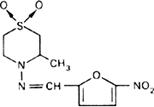Monographs: Pharmaceutical substances: Nifurtimox (Nifurtimoxum)
Molecular formula. C10H13N3O5S
Relative molecular mass. 287.3
Graphic formula.

Chemical name. 3-Methyl-4-[(5-nitrofurfurylidene)amino]thiomorpholine 1,1-dioxide; 3-methyl-N-[(5-nitro-2-furanyl)methylene]-4-thiomorpholinamine 1,1-dioxide; CAS Reg. No. 23256-30-6.
Description. A yellow to orange-yellow, crystalline powder; odourless.
Solubility. Practically insoluble in water and ether R; freely soluble in dimethylformamide R; sparingly soluble in dioxan R.
Category. Antitrypanosomal drug.
Storage. Nifurtimox should be kept in a well-closed container.
Requirements
Definition. Nifurtimox contains not less than 98.0% and not more than 102.0% of C10H13N3O5S, calculated with reference to the dried substance.
Identity tests
• Either test A alone or tests B and C may be applied.
A. Carry out the examination as described under 1.7 Spectrophotometry in the infrared region. The infrared absorption spectrum is concordant with the spectrum obtained from nifurtimox RS or with the reference spectrum of nifurtimox.
B. See the test described below under "Related substances". The principal spot obtained with solution B corresponds in position, appearance, and intensity with that obtained with solution C.
C. Dissolve 20 mg in a mixture of 2.0 mL of dimethylformamide R and 2.0 mL of water. Add 0.25 mL of copper(II) sulfate (160 g/l) TS and 4 drops of pyridine R; a dark green colour is produced. Add 5 mL of chloroform R and shake; the green colour remains in the aqueous layer.
Melting range. 178-182°C.
Sulfated ash. Not more than 1.0 mg/g.
Loss on drying. Dry to constant weight at 105°C; not more than 5.0 mg/g.
Related substances. Carry out the test as described under 1.14.1 Chromatography, Thin-layer chromatography, using silica gel R6 as the coating substance (a precoated plate from a commercial source is suitable) and a mixture of equal volumes of ethyl acetate R and hexane R as the mobile phase. Apply separately to the plate the following 3 solutions in acetone R: (A) 10 μl containing 10 mg of the test substance per mL, (B) 2 μl containing 1.0 mg of the test substance per mL, and (C) 2 μl containing 1.0 mg of nifurtimox RS per mL. Allow the spots to dry before placing the plate into an unsaturated chromatographic chamber and develop the plate for a distance of 10 cm. After removing the plate from the chromatographic chamber, allow it to dry in air, and examine the chromatogram in ultraviolet light (254 nm). Any spot obtained with solution A, other than the principal spot, is not more intense than that obtained with solution B.
Assay. Dissolve about 0.1 g, accurately weighed, in 20 mL of dimethylformamide R and 80 mL of ethanol (~750 g/l) TS. Add 5 mL of hydrochloric acid (~250 g/l) TS and start to bubble carbon dioxide R into the solution, keeping it up throughout the determination. After 3 minutes add 30.0 mL of titanium trichloride (0.1 mol/l) VS and 3 mL of potassium thiocyanate (200 g/l) TS. Allow to stand for 15 minutes and titrate the excess titanium trichloride with ferric ammonium sulfate (0.1 mol/l) VS. Each mL of titanium trichloride (0.1 mol/l) VS is equivalent to 4.788 mg of C10H13N3O5S.